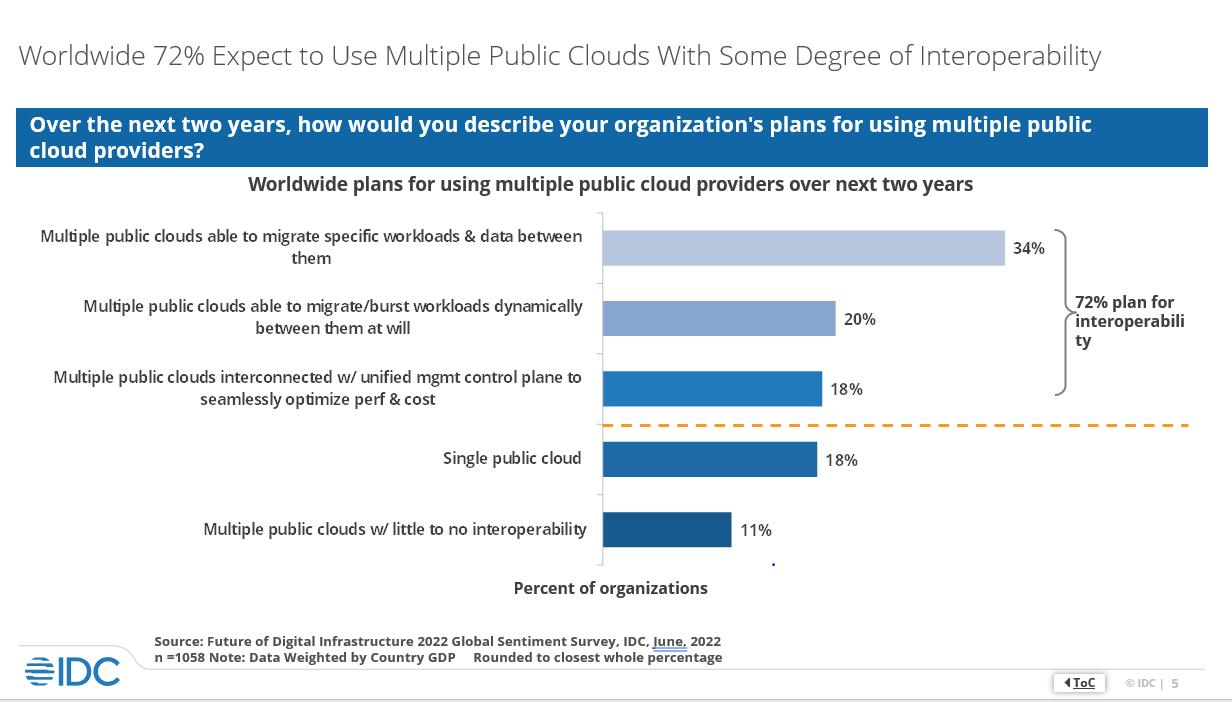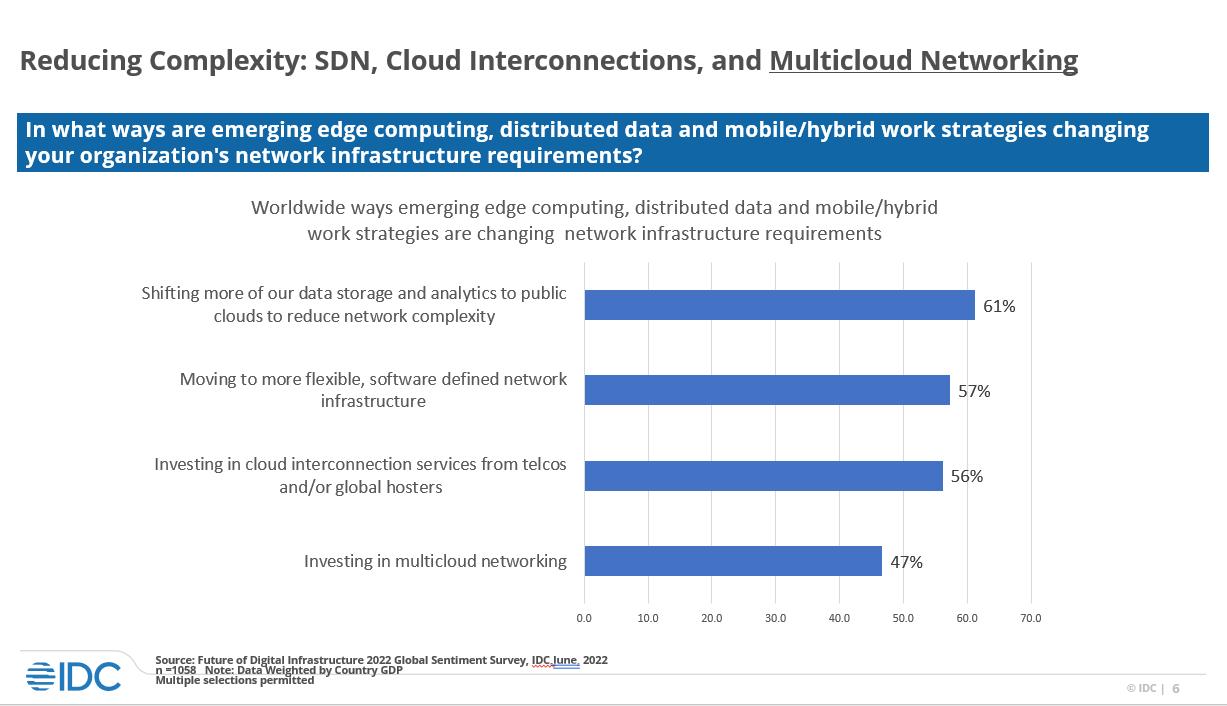
Written by Guy Matthews, Editor of NetReporter.
The growing adoption of hybrid and multi-cloud IT postures has redefined the parameters of the datacenter, and with it the network. So believes Brad Casemore, Vice President Research, Cloud and Datacenter Networking with independent analyst firm IDC.
“The traditional datacenter was a fixed on-premise entity,” he observes. “But as workloads started to migrate to cloud, it all changed. We saw changes in terms of architecture, infrastructure and the operating processes that support business workloads.
The datacenter is now a distributed entity that extends from on-premise data to public clouds, running not only modern applications but also some refactored applications. And that’s why how you connect all of this is so critical.”
Old ways of connecting are not sufficiently agile or flexible, says Casemore: “They don’t have the elastic scale of cloud,” he explains. “Multi-cloud has changed everything. That’s why we asked organizations to describe their plans for using multiple cloud providers.”
Figure 1: Enterprise multi-cloud plans

The big takeaway from IDC’s findings is that 72% of enterprises are looking at some degree of interoperability between clouds.
Connectivity is needed to provide the required elasticity, says Casemore: “If you think about the principles of software-defined networking and intent-based networking we’re seeing a move in the direction of those mechanisms, which makes perfect sense,” he observes.
Figure 2: Coping with complexity

“Multi-cloud networking has moved from a relatively fringe concern to the center of the radar screen,” he notes. “It has to support distributed workloads across clouds so it needs to be on-demand, elastically scalable, highly available and secure. It should include abstractions that simplify networking to and across disparate clouds, because each cloud has its own APIs, its own infrastructure and network constructs. You have to find a way to mitigate the complexity of operating across them because that complexity incurs significant costs. It should deliver the operational agility and efficiency that organizations need.”
To find out more about the kind of technology that’s required for networking hybrid and multi-cloud, and the benefits that accrue from it, Casemore checked with a panel of key cloud stakeholders.
Ramesh Prabagaran is Co-Founder and CEO with cloud networking start-up Prosimo. He notes that cloud is all about speed and a focus on applications, while networking is more about performance, reliability and solid architecture: “It’s the marriage between the two that makes cloud networking important,” he says. “It’s where you can operate infrastructure at the speed of applications. Primary benefits are around speed of infrastructure, the same speed as for applications.”
Pere Monclus is VP and CTO with the Network and Security business unit of VMware. He observes that traditionally, networks have been about moving packets from point A to point B, monitoring packet loss and latency as they go. Now it’s all about the application: “The benefits of a multi cloud architecture is that we start getting into what I call the business fabric, seeing how we add value to the business in terms of how users experience applications. How we can have data anywhere that it is needed. If we think like that, the network has to evolve, and is evolving.”
There are a number of benefits of moving applications to the cloud, believes Keyur Patel, Founder and CTO of multi-cloud networking specialist Arrcus: “Application performance increases dramatically with multi-cloud in a number of ways,” he notes. “You can start building fabrics. Plus cloud provider backbones are known for low latency and jitter, and high performance and throughput. Edge computing becomes interesting as you can move applications seamlessly across different points in the network. The network is going to be the key. We like to think this is actually an evolution of networking, call it Networking 3.0 if you like. It’s going to be all about end user experience, and about fabrics evolving to support deep analytics.”
Jason Purvor, Cloud Transformation Practice Lead with Google, turns the conversation to security, revealing that Google recently fought off the largest DDoS attack in history: “We did that using technology we call Cloud Armor,” he explains. “I see this as part of a trend that we are pushing which is that security and protection should be almost an invisible shield. Customers shouldn’t know that they’re accessing underlying architectures, or have to see password requests all the time. It’s about Zero Trust but at the same time Zero Friction. I think that that’s an important trend and the network is key to that.”
So how do organizations assess multi-cloud requirements? Patel of Arrcus believes that for enterprises looking to transition to cloud, there are critical factors that they should be thinking about: “One is the application user experience,” he says. “What kind of applications are you moving to cloud? How do you build the networking fabric there that gives you low latency, high performance, low jitter, scale and is secure. Then how do you keep the cost down?”
Prabagaran of Prosimo has worked with a number of organisations at different stages on their cloud journey: “Success factors largely depend on where the customer is in their cloud adoption cycle,” he says. “If we are talking about enterprises that are early to the cloud, then they’re trying to build network highways. Network highways have to be fast, reliable, elastic. We’ve also seen scale coming into the picture quite a bit. There are requirements for time to resolution, and a good observability stack so you can debug problems a lot faster.”
“One of the key things you need to consider as you’re taking the leap from on premise into cloud is executive sponsorship,” argues Purvor of Google: “A lot of migrations are unsuccessful because they’re about moving from datacenters to the cloud without really considering the optimization or the way in which applications speak to each other,” he notes. “We’ve seen challenges where customers end up tromboning between on premise and cloud and end up with a big egress cost at the end of the month and wonder where it came from.”
When it comes time to balance risks against rewards, Purvor of Google sees one of the key rewards as an improved security posture: “Hyperscalers are literally spending billions to protect, from the server all the way up to the outer reaches of the network,” he claims. “Those budgets are defending against things like DDoS attacks. Protection and security are a big part of it.”
Prabagaran of Prosimo notes that with multi cloud moves, it is usually apps that move first, then data and finally the network: “The network is usually somewhat last to come along,” he says. “Organisations can approach this in one of two ways. They can have a safety blanket of sorts and secure highways, carrying out basic hygiene so nobody’s putting a gun to your head. Or at the stage of early discussions have an architectural blueprint so that as you move to the cloud, you’re not getting dragged along but rather bringing the right infrastructure into the mix. Get involved early and the rest will follow.”





